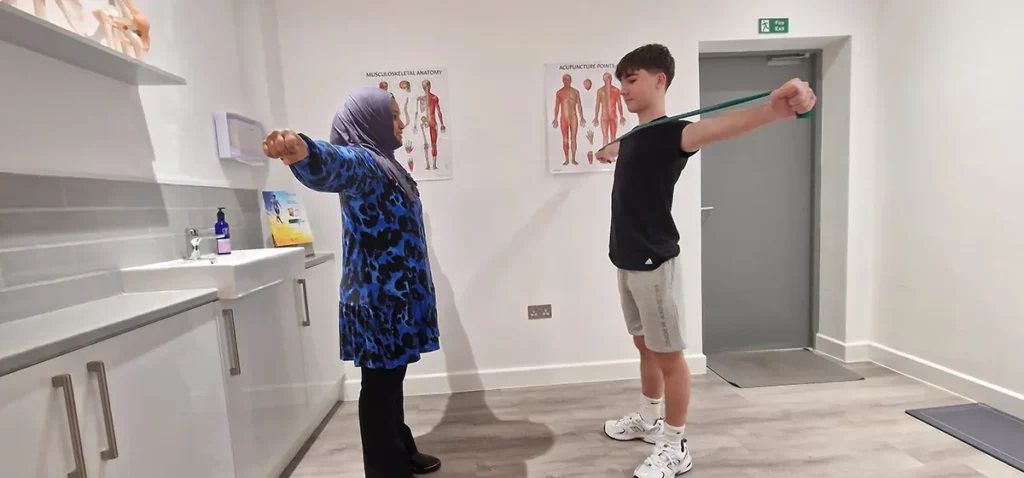Sports Injuries

Common Sports Injuries and the Role of Physiotherapy
Engaging in sports and physical activities brings numerous health benefits, but it also comes with the risk of injuries. Sports injuries can range from minor sprains and strains to more severe fractures and dislocations. Physiotherapy plays a crucial role in the treatment and rehabilitation of these injuries, helping athletes recover faster and regain optimal function. Here, we’ll discuss some of the most common sports injuries and how physiotherapy interventions can aid in their management and enable athletes to return to their pre-injury levels.
Common Injuries
1. Sprains and Strains:
- Sprains occur when ligaments, which connect bones to each other, are stretched or torn. Common sites for sprains include ankles, wrists, and knees.
- Strains involve the stretching or tearing of muscles or tendons, which connect muscles to bones. Hamstring and groin strains are frequent in sports.
- Physiotherapy focuses on reducing pain and inflammation through modalities like ultrasound and acupuncture, as well as restoring range of motion and strength through targeted exercises. Techniques like manual therapy and taping can provide support to the injured area, aiding in recovery.
2. Knee Injuries:
- Knee injuries are prevalent in sports like football, basketball, and skiing. They include conditions like anterior cruciate ligament (ACL) tears, meniscal tears, and patellofemoral pain syndrome.
- Physiotherapy aims to improve knee stability, mobility, and strength. Therapists may prescribe specific exercises to strengthen the muscles around the knee, as well as techniques like proprioceptive training to enhance balance and coordination.
3. Shoulder Injuries:
- Rotator cuff injuries, shoulder dislocations, and shoulder impingement syndrome are common in sports involving overhead movements, such as swimming, tennis, and baseball.
- Physiotherapy interventions may include exercises to strengthen the rotator cuff muscles, improve shoulder flexibility, and correct posture. Manual therapy techniques can also help reduce pain and improve joint mobility. To speed up the healing process, modilities such as ultrsound as well as
4. Stress Fractures:
- Stress fractures are tiny cracks in bones caused by repetitive stress or overuse. They commonly affect the feet, legs, and lower back, particularly in runners and athletes involved in jumping sports.
- Physiotherapy focuses on identifying and addressing biomechanical factors contributing to the stress fracture. Treatment may involve modifying training routines, prescribing orthotics or supportive footwear, and implementing a gradual return-to-sport program.
5. Concussions:
- Concussions are mild traumatic brain injuries resulting from a blow to the head or violent shaking of the head and body. They are common in contact sports like football, rugby, and hockey.
- Physiotherapy plays a vital role in managing post-concussion symptoms and facilitating safe return to activity. Therapists may utilize vestibular rehabilitation, vision training, and graded exercise programs to address balance, coordination, and cognitive function.
6. Achilles Tendinopathy:
- Achilles tendonitis involves inflammation of the Achilles tendon, which connects the calf muscles to the heel bone. It often occurs in runners and athletes involved in jumping sports.
- Physiotherapy focuses on reducing pain and inflammation through modalities like ultrasound therapy, as well as stretching and strengthening exercises targeting the calf muscles and Achilles tendon. Eccentric loading exercises have been shown to be particularly effective in tendon rehabilitation.
7. Tennis Elbow and Golfer's Elbow:
- Tennis elbow (lateral epicondylitis) and golfer’s elbow (medial epicondylitis) are overuse injuries affecting the tendons in the elbow. They commonly occur in athletes who engage in repetitive gripping and wrist movements.
- Physiotherapy interventions may include manual therapy techniques to release tight muscles and fascia, as well as eccentric strengthening exercises to improve tendon resilience. Therapists may also provide advice on activity modification and ergonomic principles to prevent recurrence.

To Summarise...
In conclusion, sports injuries are a common occurrence among athletes whether you are a pro, elite or even a casual hobbyist. With appropriate physiotherapy intervention, individuals can recover effectively and safely return to their sport. Physiotherapists play a crucial role in managing sports injuries by providing personalised treatment plans focused on reducing pain, restoring function, and preventing future injuries. Through a combination of hands-on therapy, electrotherapy, Acupuncture as well as taping, we are able to help manage symptoms associated with the injury. We use exercise prescription, and education ro help athletes regain confidence in their abilities and achieve optimal performance on and off the field. Our physiotherapists will work with you to provide return to sport.